June 22, 2017: 11:00am - 1:00pm
THIS IS A TRANSCRIPT FOR THE TRIBAL TECHNICAL ASSISTANCE PROGRAM WEBINAR ON JUNE 22, 2016.
>> We will give it one minute and then start.
>> Adam are you on and able to connect? Victoria let me know when you want to start.
>> I think we can.
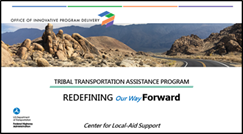
>> Good morning and good afternoon ladies and gentlemen. Thank you for standing by. Welcome to the presentation tribal technical assistance program. Re-defining our way forward. At this time, all participants are in listen only mode and later we will open the lines for comments. If you should require assistance during the call please put that in the chat pod and I can see how I can help you. As a reminder, this webinar is being recorded and I will like to turn the webinar over to Victoria.
Thank you, Sharon. Good morning or afternoon to everybody depending on which time zone you are calling in from. We are very pleased that you can join us today. My name is Victoria peters I am the director of the Center for Local Aid Support in the Federal Highway Administration's Office of Innovative Program Delivery. We want to make this presentation interactive so please post your comments and questions over in the chat pod that is over on the bottom left. As we go through this presentation at the end we will be given instructions on how to give your feedback over the phone line if you're more comfortable in providing it that way. First we will have Tony our Chief Innovation Officer provide us with a few opening remarks.
>> Tony you are going to have to hit*six*6 to unmute your phone.
>> Thank you Victoria and Good Morning or Afternoon to all of you on the webinar. When Victoria and I assumed responsibility for the Tribal Technical Assistance Program about a year ago we had five-year contracts for three centers that were expiring and the other four had completed their base years and were into their option years. These contracts started at different times and were based on different Statements of Work. As we thought through how we would proceed, we began evaluating where the program was in its delivery of services to the tribes. We looked through the existing statements of work and, more importantly, looked through the data that the Centers themselves provided to us on the delivery of training and technical assistance to the tribes.
Then we started thinking through options. Our focus through all our thinking, then and now, is how can the TTAP best meet the needs of the tribes in transportation training and technical assistance. How can we focus more resources on providing the basic mission of this program? Is the current model for delivery of the TTAP the best model? Can we consolidate administrative functions to reduce overhead and shift that time and energy into training and technical assistance? Can we leverage other resources? Can we take advantage of advancements in learning options while maintaining face-to-face interaction to help the tribes solve particular problems? I want to thank the Tribal Transportation Program Coordinating Committee for their invaluable assistance in vetting options and helping us shape our thinking. It was this Committee that advised us to seek broader input from the tribes and it was their recommendation that was the genesis for these webinars. As Victoria noted her letter to all of you announcing these webinars, in order for us to be able to put the full scope of our proposal before you in these webinars, we had to put a draft SOW in the public domain. Since that's now been done, we can proceed in that broader conversation with you.
Victoria will now walk you through the model we are proposing for the delivery of the TTAP, but before she does, I want to thank her publicly for her efforts in pulling this together. Victoria has poured herself into looking for ways to deliver the best possible program to the tribes. Thank you, Victoria.
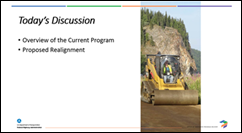
>> Thank you Tony. I will now give you a little background of the current program and walk you through some key concepts of our proposed new model.
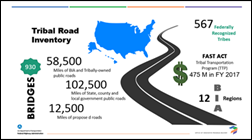
>> The Federal Highway Administration has the broad responsibility of ensuring that America's roads and highways continue to be the safest and most technologically up-to-date. State, local, and Tribal governments own most of the Nation's highways and FHWA provides financial and technical support to them for constructing, improving, and preserving the highway system. The tribal road inventory currently consists of approximately 58,500 miles of BIA and Tribally-owned public roads, 102,500 miles of State, county and local government public roads, and 12,500 miles of proposed roads. This inventory also includes 930 bridges. All statistics that I'm sure you're very familiar with. The FAST Act continued the Tribal Transportation Program (TTP), which provides highway access to basic community services to enhance the quality of life in tribal communities. The program is receiving $475 million in FY 2017, with increases of $10 million per year to $505 million in FY 2020. The FAST Act allocates TTP funding to the Tribes through a statutory formula based on tribal population, road mileage and average tribal shares. A portion of the Tribal Technical Assistance Program is funded under the TTP set-asides.
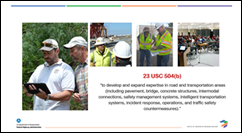
>> The larger portion of the funding comes from FHWA's Training and Education program. In 1981, the concept of a rural technical assistance program first appeared in a conference committee report on appropriations for the U.S. DOT. It wasn't until 1991, that Congress widened the program's scope to include Tribes under the Technical Assistance Program. This expansion authorized the program to directly serve Native American tribal governments. Since the Intermodal Surface Transportation Efficiency Act was signed into law on December 18, 1991, the Tribal Technical Assistance Program can officially celebrate 25 years of TTAP legislation. Four TTAP centers were initially established in Colorado, Michigan, Montana, and Washington. The TTAP Center at Oklahoma State University (OSU) was started in 1995. Also, that year, a sixth center began operation in California, followed shortly by a seventh center in Alaska.
>> I'm going to take a second to pause because my screen has totally gone blank and I'm just wondering if the same has happened to everybody else.
>> Victoria my screen is up so if you have your slides just tell me when to move it and I can go with that. Your currently on the slide that has 23 USC 504.
>> You can move to the next slide.
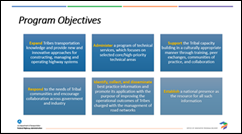
>> The overall objective of the TTAP is to deliver a highway training curriculum and technical assistance to provide the tribes with tools to build their capacity, means to innovatively address their roadway network challenges, and be reflective of FHWA's current core areas. The key objectives for the TTAP are identified on the slide. They include expanding knowledge and providing new innovative approaches focusing on selected high priority technical areas, supporting tribal capacity building, encouraging collaboration across government industry, disseminating best practices and establishing national presence as a resource for these materials.
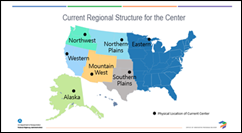
>> Currently, there are seven TTAP Centers include the Mountain West TTAP Center in Gilbert, AZ; the Northwest TTAP Center at Eastern Washington University; Eastern TTAP Center at Michigan Tech University; the Alaska TTAP Center at the University of Alaska-Fairbanks, AK; the Western TTAP Center at the National Indian Justice Center (NIJC) in Santa Rosa, CA; the Northern Plains TTAP at the United Tribes Technical College in Bismarck, ND; and the Southern Plains TTAP Center at Oklahoma State University.
The structure of these centers was developed in 1991. Let's step back and review what was happening a quarter of a century ago. The Intermodal Surface Transportation Efficiency Act restructured the federal-aid program. It was considered the most important bill since President Eisenhower started the Interstate System. It was considered the start of a “new era for transportation” focusing on system performance rather than system building. The conflict in the Persian Gulf had ended and President Bush's first priority was to get the economy rolling again and enact the legislation that is key to building a better America. It may sound familiar.
The first website went live in 1991 and the internet was used by physicists and scholars. Now the internet has changed literally everything that we do – how we keep in touch with friends and business connections, the way we shop, and how we get our news – it's all changed over 25 years. Remember encyclopedias, they are now obsolete, information is gained on a click of a button. In 1991, big bulky notebook computers hit the market. Hard drives were a whopping 80 MB and they had floppy disks! The second generation or (2G) phone technology hit the market in Finland. It was another 10 years before 3G was launched and of course we all want 4G at this point. Kodak introduced their digital camera and we probably have some gamers online. So it's notable that super Nintendo was launched and a gallon of gas was a dollar and 12 cents.
In the pre-Personal Computer era, futurists predicted huge changes in transportation. By 2008, we would be flitting about in personal jetpacks and taking vacations on the moon. But the communications revolution, spurred by personal computers and the Internet, wasn't on anyone's radar.
The next quarter century still may not have us commuting using jetpacks, but we will see technology used that as you approach a dangerous intersection, sensors in your car will detect it and reduce speed. Construction processes and methodologies will continue to evolve. We will manage our networks with real-time travel data. Once again our Nation's transportation community is entering an unprecedented “era of change”. One thing for sure is that it will continue to be difficult for agencies to attract and retain a capable workforce. As much as 50 percent of the transportation workforce will be eligible for retirement in the next decade. (How many of you will still be working?) As these workers depart, they will take valuable knowledge and skills with them.
Today, massive amounts of information are available at your fingertips. Opportunities for communication and collaboration have also been expanded by technology. Today, technology enables forms of communication, training and collaboration undreamt of 25 years ago. The walls of the regional boundaries or training rooms are no longer a barrier. The advancements over 25 years have profoundly changed our ability to deliver training and education and lends itself to reconsidering a new delivery model.
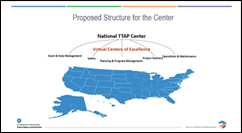
>> FHWA is proposing a two-year pilot to maintain one national TTAP center. Operated under the national Center will be 5 Virtual Tribal Centers of Excellence providing expertise best practices, support and training in the highway areas of asset and data management, planning and program management, project delivery, safety, operations and maintenance and included without a national tribal road scholar certificate program. By establishing a national tribal technical assistance program, a national TTAP center the FHWA proactively creates cadre of professionals, specialist in critical Highway topics.
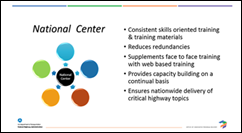
>> The mission of the national TTAP center will be to provide and facilitate quality training and technical assistance for Tribes in support of the highway program. The center's leadership ensures that its training and technical assistance programs promote a technically capable tribal workforce. One priority will be to provide consistent skills based training on issues that challenge tribes in managing and operating their road networks. Many of the past administrative functions of the seven-center model are placed under the national center to reduce redundancies and to make more of the funding available for training and technical assistance and to support travel for face-to-face interaction between the subject matter experts and the tribes. A second priority is to ensure that the greatest number of tribes are served at the lowest cost. To this end, a combination of training delivery methods will be incorporated into the center's delivery. The Center will be asked to work closely with the LTAP centers in the states in which the tribes reside to take advantage of existing training delivered by LTAP centers. Most importantly, the national center will be responsible for ensuring training and technical assistance is delivered across all 12 BIA regions.
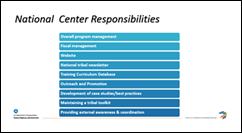
>> In additional to overall program management, the staff assigned to the national center will be responsible for developing a national tribal website. The website will be a one-stop shop for tribes to obtain training information, find resources, learn about best practices and share transportation news. A quarterly electronic newsletter will be produced to share program updates, highlights, upcoming events and tribal success stories. The national center will manage a database of the TTAP training curriculum, develop tribal case studies and create a tribal toolkit that contains guidance documents, sample policies, standard specifications and plans, and example templates used in delivery of the transportation program. The national center will coordinate with state and local governments, academia and industry organizations and collaboratively facilitate conversations between these entities and tribes. The national center should be considered the tribes point of contact for training and technical assistance needs.
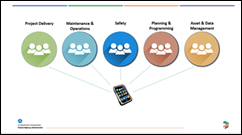
>> The programs footprint will be maximized by operating five virtual centers for training and technical assistance. These centers are virtual and the staff can be seated anywhere in the US. Physical locations for theses Virtual Centers of Excellence are not required. Each of the virtual centers will be comprised of subject matter experts responsible for the delivery of training and technical assistance in their focus area. Once this is in place, you will have experts available at your fingertips. If you have a safety program, you will hear from a safety expert. If you have a maintenance question, a maintenance expert will assist you. These experts will have access to the additional resources of FHWA and other organizations to ensure you get the best information to resolve your questions. The subject matter experts will share their knowledge and expertise across all 12 BIA regions.
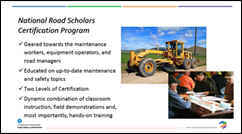
>> In addition to the virtual centers, a national Tribal Road Scholars' Certification Program will be developed. Delivery of the certification program will require a physical location and equipment to provide the necessary skill development for the certification. This program can be co-located with the National TTAP Center or located in another physical location within the U.S. The RS program will provide the most comprehensive and up-to-date skill development in maintenance and operations topics. It will include training on heavy equipment operations such as Motor Graders, Skidsteers, Backhoes, Forklifts, Excavators, Loaders, Haul Trucks and Rollers. The goal is to provide skill development consisting of approximately 50% classroom to 50% field training. Due to the need for field based skill development, equipment availability and facilities that support hands on training, the tribes will need to travel to the Center location to complete some of the Road Scholar curriculum.
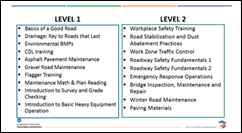
>> The certification will be provided in two levels. Level I and II. Included in the program will include an on-line preparatory course, classroom training, hands on field equipment skill development, examination, recertification and retesting. Proficiencies after each class shall be measured by pre-and post-tests. Individual achievement will be a minimum score of 75%. In the future, when a new employee joins your workforce and they indicate that they have the Tribal Road Scholars certification, you can be confident they have been trained consistent to those on your staff who retain a Tribal RS certification.
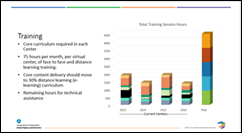
>> Now, I would like to go back and take a closer look at the training that will be provided. Within the statement of work, we have identified a core curriculum in each of the focus areas. The delivery will include basic through advanced training, to build a strong tribal network of roadway knowledge. Training under this contract is set at a minimum of 75 hours per month per virtual center of face to face and distance learning training. To illustrate the impact of this requirement, the graph shows the training hours that have been provided over the past four years in comparison with the proposed amounts under the pilot.
Since we intend to build skills with our training, session length for the core curriculum will range from 4 hours to multiple days. We are also asking that the subject matter experts consider local issues and problems identified by their audience in the delivery. The virtual centers' role IS to deliver training and technical assistance. Specific training and education areas outside of the core curriculum will be identified by the FHWA annually. We have asked the Tribal Transportation Program Coordinating Committee to assist us in identifying new needs.
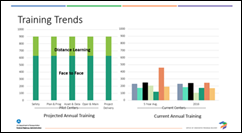
>> As you can see in the first graph, the core content delivery under the pilot will be delivered in both classroom (face to face) delivery, and distance learning. We are asking that the curriculum during the pilot incorporate a 30% distance learning (e-learning) delivery. This will provide tribes with on demand learning in many of the core curriculum topics. On the same scale a comparison is made to the TTAPs 5-year average and their last years training delivery.
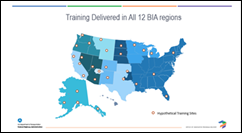
>> Training and technical assistance in each focus area is required to be given across the nation in all 12 BIA regions. For example, the dots represent potential or hypothetical locations of safety training during one year. Then visualize adding a similar number of locations for each of the other focus areas.
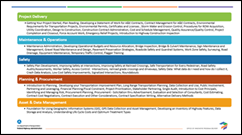
>> As discussed, we have identified a core training curriculum in each of the focus areas. This slide is busy and I don't expect you to read it. However, the busy ness conveys the depth of the curriculum that is important to the Tribal workforce. And then add to this training the Road Scholars certification program for a full package. We will work towards a no-fee structure be employed for training and technical assistance. We know this has varied throughout the regions in the past.
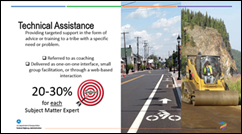
>> Each subject matter expert, in addition to their training role, should anticipate dedicating 20-30% of their time to technical assistance. Technical assistance or coaching is provided on a one on one consultation with an individual or small groups or through web-based interaction. We are requesting that all technical assistance requests and issue resolutions be reported.
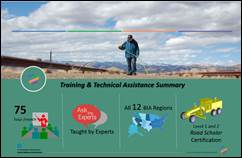
>> So, in summary under this proposal, we are looking for an increase in training and technical assistance provided by the TTAP. Both training and technical assistance will be provided by experts in specific subject areas. The national center will be required to ensure the training program delivered by the virtual centers is delivered in all 12 BIA regions and we will create a national Tribal Road Scholars certification program.
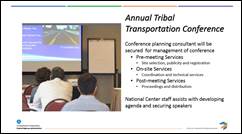
>> Traditionally, the Annual Tribal Transportation Conference has been hosted by one of the TTAP centers. They have been responsible for logistics, registration, securing vendors and speakers and setting the agenda. Starting in 2018, the management of this annual conference will be performed by another entity. We will be soliciting for proposal to provide this service under a separate request later this year. The National TTAP center will assist FHWA in developing the agenda and securing speakers for the event. This will enable more TTAP resources to be dedicated to training and technical assistance.
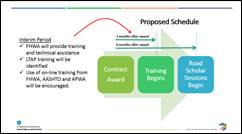
>> Once the contract is set in place, there will be an interim period before the new Center is fully functional. Training by the virtual centers will begin approximately 3 months after contract award. We anticipate the road scholars' facility will take a bit more time to become operational, therefore, we anticipate the program being on line 6 months from contract award. During the interim, FHWA will provide training and technical assistance. We have reviewed the training schedule of past years during the winter months and anticipate meeting the needs with our Resource Center, Federal Lands and Program Office staff. We will also identify and coordinate LTAP training for tribal participation. We also are currently discussing with AASHTO and APWA ways to make their on-line training resources available to both local agencies and tribes.
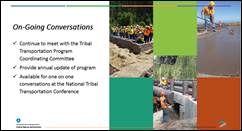
>> This is not the last time you will hear from us. We will continue our conversations. We will work closely with the TTPCC to review performance and identify the future needs of the program. We will provide an annual update in a similar format as today on the success of the pilot program and receive your feedback. Staff from the Center for Local Aid Support will also be available for one on one conversations at the National Tribal Transportation Conference in September.
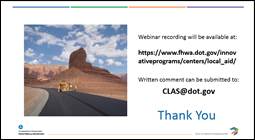
>> After this webinar, we will make the webinar recording available on the CLAS website. You can provide written comment until July 3rd by sending your comments to our email address – CLAS@dot.gov. We would now like to open of the telephone lines to listen to your feedback on what we have presented here today. Thank you.
>> Victoria prior to opening the lines would you like to answer some of the questions that are in the chat room?
>> I would like to open the lines for the session.
>> Okay.
>> Hold on one second. Everybody you are in interactive talk. You are also being recorded. There is a little guy on top with his hand raised on the top of the screen. If you can push that just know that you have a question and I can call on you and tell you how to open the line. Anybody have any questions? The line is open you can ask your question.
>> This is Kelly Anne.
>> I'm sorry I do see you have your head up as well Jake so after her question I will call on you Jake. Go ahead.
>> I just wanted to know when the pilot project was [ Indiscernible].
>> Draft sources sought and the draft statement of work is being advertised. I think those documents would be up on that website until July 6. At that point we will look at all the comments and everything that we have received and then we will relook at what a statement work will look like for the RFP. We anticipate then turning around and making those modifications and posting it later this summer. Our target to have something in place is in October. That would put the new center training which the slide indicated about three months after that.
>> Okay Thank you.
>> Victoria before we do that I'm going to mute the lines because I'm getting a lot of background sound. Then Jake once I do that I will tell you how to open your line. Jake, can you hit * six.
>> Jake, can you hit * six. Thank you. >> Your line is open. I can't hear you. You might want to do it one more time. * six. Is your line on mute? Jake go ahead and speak .
>> Good morning and again this is Jake I just wanted to inquire a little more about the national Road scholar program and what is the plan in terms of getting this particular plan going and could we in the future could we improve our program. [Indiscernible].
>> Let me back up to the road scholars curriculum to help answer that question. This is the curriculum that will be taught in that Road scholar program and its focused-on staff that are hands-on in that maintenance and operation part of maintaining your roadway. At level I you will have to receive that level I certification and you will go through the basics of the road. You will get some of the plan reading, maintenance map and learn how to [Indiscernible] and that is where we are looking at including some of that heavy equipment training. Once you have been certified at that level, your staff will be able to move into a level II certification and you can see we have added what we consider a little bit next level training but still focused on that maintenance on operations staff and those who are taking care of your current networks. There will be another virtual center if you would just want maintenance and operation topics or training or technical assistance you would go to the virtual center for maintenance and operations. They will be providing additional training for topics. You just won't be receiving the certification by attending some of their classes. We allowed it so were still gain a recovering maintenance and operation topics and still have subject matter expertise available to you in maintenance and operation but if you decide you definitely want that certification and want that hands-on's training that you could only get when you put your hands on that equipment you will be looking at the Road scholar certification program.
>> This is not just a time for questions it's a time for comments as well anybody else?
>> Would you like me to read any of the comments in the chat?
>> There are many tribal programs who wear multiple hats in the program. Where would they find the time to complete web-based training or travel to a classroom ? travel programs are grossly underfunded. Where is the travel money going to come from?
>> We are hoping we can get that training distributed around your location so it's close enough so it's not a huge expense to attend. We have a lot of multiple hats out there so we know for some individuals they would want to participate in all the training out there. I think that is part of the reason we are moving to that e-learning or distance learning so the distance there is on demand. On-line have that time where when you staff has the hour of time you can go and pick it up right there off your computer. I know many have asked for that because sometimes you need the training today because something is happening within your program or project and either you need the new information or just that refresher as you walk into it. Many have asked for this type of training. Also, there has been others asking for it because of the cost to travel. This would allow them to receive some of that training without having to travel. I totally get it, face-to-face is a way that most people like to receive training. You're trying to give you options and when you can make it and you can travel there will be face to face training that is hopefully somewhere close to your neighborhood. I can't promise that it would always be there at your location you may have to travel to one of the other locations in your area to receive that training. Were going to try to move it around so it's not always in one location.
>> I have another question from Adam. The question is, the tribal certification why can't this funding for this program be included in the existing TTAP that we have available to us. He also stated this funding can be bundled into the program and have them offer these trainings.
>> This is not new funding. This is the funding that we already have dedicated in this program and that is what will support this proposed pilot. There is no new or additional funding is using the existing funds that we have and hoping we can find addition fees in what we have laid out so we can actually put the money we save from being efficient on some of the administrative tasks to more training and technical assistance.
>> If there are issues with the current TTAP why are they being assessed and given ways to improve the program instead of getting rid of them. Who is the TTAP oversight and did they let it go this far?
>> I'm reading through the question. We are looking more to efficient and effective ways to deliver the program. I think the model that we have laid out allows us to capture on some of those efficiencies and allows us to better target subject matter experts rather than having one center, similar to what you do, wearing multiple hats and training in multiple areas. We can target subject matter experts for those specific training under the model much more effectively than we can under the existing model.
>> Great. We are going to go ahead and do you have anything else to add Victoria?
>> I would like to open the phone lines to anybody that would like to provide any feedback or comments.
>> This is Mary Beth. I have some questions and one of my concerns are I am all for tweaking programs and some of the ideas you have laid out on the webinar I think are good. My question is, during [ Indiscernible ] why was it so rushed ? [ Low Volume ] I know you mentioned on the letter you took it to the TPP cc committee but what I have been finding out is that they were told they couldn't even [ Indiscernible ] the tribe about it. Why is that going on and why hasn't [ Indiscernible ] been consulted about this from the various -- the very start . Back in 1991 Back in 19 91/500 tribes [ Low Volume].
>> I hear you. By re-competing the contracts which we have to do because some of them cannot be extended and we have to re-compete as full and competition. We did want some tribal feedback that's why we went to coordinating committee to get some feedback and get some ideas. As we're moving forward but until this point until we couldn't actually put this on the streets and went through that process with our acquisition we cannot open this up necessarily for broad discussion. We used the coordinating committee in an advisory capacity to bounce some of the ideas to them and get their feedback as far as opening up to everybody we waited until this point where we [Indiscernible]. At this point it is open for discussion.
>> A follow up with a question. Was there any tribal representation on your drafting committee ?
>> The additional framework was shared. Parts and pieces of it. Certain areas where we had questions with the coordinating committee and that advisory type role. Basically, not on the write up is what you're seeing
because I had to go through acquisition process and because this is a competitive solicitation. No we did not have that at the final.
>> Hello.
>> Go ahead with your question.
>> My name is Adam. [Low Volume] I am new to the transportation world here. I am happy with the existing TTAP that we have and I work with Northwest TTAP directed by [Indiscernible] and I run into situations all the time in my job where I have questions that come up and stuff that I'm doing in my job. I already have TTAP on my fingertips right can just call or send an email to them and asked them about a situation I'm going through and within the same day or sometimes the next day they get right back to me with the solution and the problems that I ran across. I would hate to see that go and because they understand our culture and the ties that we have and transportation and all of that one of my questions is, how many people in this new program that you tried introduced to the tribes, how many of them have the knowledge with what tribes go through and their daily struggle with transportation issues. I think I worded that right.
>> I can't tell you that today because it's not out there open for bid so we don't know who is responding. That's one of the things we put in that statement of work if you were to read it. We're looking for subject matter experts that have the tribal expertise, the tribal knowledge so we are asking applicants to look for subject matter experts with those ties.
>> You are saying -- does that mean you keep your existing TTAP who have the knowledge and play in this program?
>> No I'm not saying you will keep the existing. The only way the existing staff would remain is if they became an applicant to the new proposal. Either they could be part of or take it on as the national Center or they can put together a contortion and be part of a group that delivers the program.
>> Scott your line is open you can ask your question.
>> This is Scott I'm with the [Indiscernible] colony in Nevada. The comment in the couple questions if I may I think one of the key advantages of the existing TTAP around the country is a regional knowledge that they have been with transportation and construction projects within the region. The comment I would make in terms of construction management and building transportation infrastructure I think it's different here in the Southwest than up in Alaska or back East. I was curious with the proposed consolidation of getting rid of the existing TTAP that was based until one national contortion. How with that regional technical knowledge to be retained and help benefit the tribes with their programs?
>> We are hoping that we have a mix of subject matter experts when teams come in to propose. We will be thinking in terms of not only a national program but identifying experts across the country that have different regional expertise. I do know that it's doable and I worked many years and the office of Federal lands and we have three offices. We deliver nationally and are subject matter expert are true experts and when they are providing training or technical assistance or delivering the project they get to know part of being a subject matter expert is to knowing those regional concerns and those regional issues as you are providing that technical assistance. Any other comments?
>> This is Mary Beth again. [Low Volume]
>> We are looking at this as part of that request for tribal consultation. We're hoping we are going to be over the next five days were going to continue this webinar and sharing it ever hoping that we will receive comment that only during this webinar but a comment during the open period so you can send in your and comment if you choose to deliver your comments that way.
>> Thank you.
>> Anybody else? We don't want to leave the phone line here without hearing from anybody who may want to make a comment this is your opportunity. Like I said we can it be repeating this over the next four days. I guess if you are like me and you step away from the call and you say I wish I would've mentioned this. There will be more opportunities and of course you can always send your comment into that email box or even if you have a question. I want to make a point that, the email box is there year round so please feel free to contact us using that, not only the phone but that email box is constantly monitored by my staff to make sure we get responses back.
>> Anybody else? I do not have any more to present to you. In my letter, there was a link to the federal business operations website. At that location you could download the proposed statement of work. You can read through it and see exactly the full package of what was being proposed if you have not already done that. There is also a source sought notice to determine interest in those that may be interested in delivering a proposal program like this. We are going to stay on the line for a few more minutes and just in case somebody else decides they want to ask a question we will stay here as long as needed. We are looking for that comment and feedback not the must -- much questions on what we are proposing.
>> This is Tony can you back up the slides to the one that shows training.
You can stop right there. The next one. [Low Volume] What we would like to do as you can see is open double the amount of training hours. [Low Volume] This is the data be looked at and this data comes to us directly from the TTAP centers themselves. You can see for yourself how much time is spent on training. When we look at this we said there is a way we can improve upon what is currently being delivered.
>> This is Mary Beth I really like that tone. I like the slide because it gives us a good picture of what the training has been in the past and what you are trying to achieve. My question is, how did you reach the alternative of the pilot for you could've had an alternative on how we tweak what we currently have so that it would have and reduce confusion to all of what is in place now. Is there a way to tweak the system currently instead of changing the whole road to a different [Indiscernible].
>> Marybeth the funding for this program is the same. It's not increasing so we had to find ways to increase the training and the request for face to face training to be able to find the funding to do more travel because more training means more travel. In order to do that we could not maintain existing structure. We have to find a different way and find ways to save cost and there were so many redundant activities going on within the seven centers that we felt by moving to a different model we can capitalize on removing those redundancies in order to get to this graph.
>> Okay. Thank you.
>> Hello?
>> Go ahead.
>> My name is Adam again. I think that is a good graph as well. My question and what I'm looking at in 2013, 2014, 2015 and 2016 I look at that graph as that is the amount of training that the existing TTAPs are probably available able to do with such low amount of funding they got. What do they get like 150,000 were -- per TTAP center. That's not much away to do anything with. How much funding does the new program get? How much more funding does your program get in the existing TTAP?
>> We are under the same funding whether we go to the proposed model or use the old model the funding remains the same.
>> So the funding is going to be under one program now?
>> Yes.
>> Okay.
>> Anybody else?
>> Jake again. The PowerPoint presentation this indicated it would be made available. Is there a way how this would be shared? to be give you an email address or what and how do we do it?
>> You can send your email address to us at the mailbox I'm going to flip to the last slide. We have the email box right here on the slide you can send me an email and say Victoria sent me the recording and we will get you the recording or you can just go up. After today go to this website appear and the recording will be there and we will not only put this recording there will put all five days recording there. If you want to listen and you don't have time to attend the other ones but you want to listen to parts and pieces of it that recording by the end of next week for those other four sessions will be there also.
>> The PowerPoint would be embedded in that recording so you can see it. If you send me an email to the email box I can give you the PowerPoint without the recording.
>> Okay.
>> Just send it to that email box and say Victoria sent me this.
>> Thank you.
>> Thank you Victoria.
>> Thank you. If you guys have any thoughts afterwards please send them to us.
>> Okay we will do have a good day.
>> Thank you.
>> We just hang up?
>> You can, that is what all the presentation we have.
>> Okay have a good day.
>> If anybody is still on the line and wants to talk you can otherwise Thank you for attending.
>> We have about 10 people left signed on to the website. I don't know if they are still on the webinar. We have not had any questions in about five minutes but we will stay here for about five more minutes and then we will and then end the call. I don't know if they are still on the phone line. We have not had any questions and then we will end.
>> I think everybody is pretty much off the line. I am going to go ahead and close it out.
>> Thank you.
>> [Event Concluded]
Victoria Peters 2: Welcome.
Mary Beth Frank Clark: Tat's Maywe' (Good Morning) everyone.
William Marchand: Hola
Adam Amundson: Heelo Victoria, my name is Adam Amundson, Coeur d' Alene Tribe, planning technician. Do we have to call the phone number above to get Audio?
Sharon Gordon: Please call in using 866.434.5269 access code 1171779
Sharon Gordon: Adam are you on
Adam Amundson: Yes Thank you
Adam Amundson: My screen is up!
Jake Wells: Is there a way to print the presentation?
Sharon Gordon: I will see if I can make the presentation available after the presentation.
Sharon Gordon: Thanks for asking Jake.
Jake Wells: thanks.
Dolly Ann Trefon: When will the pilot project start?
Adam Amundson: Tribes already have experts at our finger tips with already existing TTAP's available to us.
rosebud sioux tribe: There are many Tribal programs who wear multiple hats in the transportation programs, where will they find the time to complete web based training or travel to a classroom? Plus Tribal programs are grossly underfunded, where is the travel money going to come from?
Adam Amundson: The Tribal Roads Scholars Certification, why cant this funding for this program be included in the existing TTAP's we have available to us? This funding could be funneled into our existing programs and have them offer these trainings.
rosebud sioux tribe: If there are issues with the current TTAPs why are they being assessed and given ways to improve the program instead of getting rid of them? Who is the TTAP oversight and did they let it get this far?
William Marchand: I think a core curriculum nationally, coupled with a Roads Scholar program, are good ideas. Some LTAP's have such a program that I considered sending some of our staff to.
Mary Beth Frank Clark: Why was this re-org so rushed? How many tribal reps on the working committee that assisted with this draft? Why weren't tribes invited to be involved during the planning stages of this draft? I am always open to new ideas and such but like to be involved with any changes.
rosebud sioux tribe: Why isn't this "pilot program" tested on a couple small land based tribes instead of this whole revamping of this program?
Mary Beth Frank Clark: You mention TTPCC but they were not to share anything back to Tribes? Why did this happen?
rosebud sioux tribe: I agree Mary Beth Frank Clark, it appears rushed.
Mary Beth Frank Clark: I am on the Board for Northwest TTAP? This 'no communication' by FHWA working on this draft has caused concerns of forward Planning of activities and events.
Scott Carey: What is wrong with the existing format of the TTAP's around the country? How will the proposed consolidation of the regional TTAP's benefit Tribe's?
Dolly Ann Trefon: I like the idea of the training model, so that we can get more training via web based and personal contact.